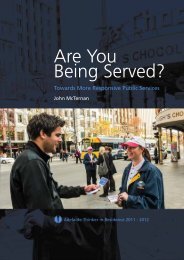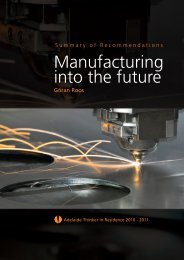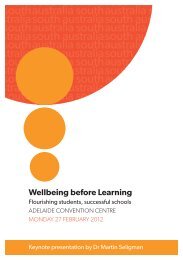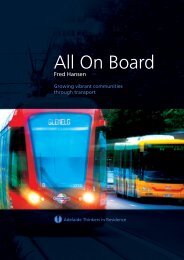Download pdf of Fred Hansen's report - Adelaide Thinkers in ...
Download pdf of Fred Hansen's report - Adelaide Thinkers in ...
Download pdf of Fred Hansen's report - Adelaide Thinkers in ...
- No tags were found...
Create successful ePaper yourself
Turn your PDF publications into a flip-book with our unique Google optimized e-Paper software.
a pedestrian path. This can be reflected <strong>in</strong> materials and landscape treatment. The design<strong>of</strong> the <strong>in</strong>tersection between people and cars must always re<strong>in</strong>force that people come first,cars second.RecommendationsThe Transportation Master Plan will need to provide practical pr<strong>in</strong>ciples andprocesses to achieve this, everyth<strong>in</strong>g from best practices for footpath and<strong>in</strong>tersection treatment to light<strong>in</strong>g and other enhancements. Many areasthroughout the world have done this and it will be relatively easy to identifymodels to learn from and adapt.• Improvements must be made <strong>in</strong> how pedestrians <strong>in</strong>teract with vehicles <strong>in</strong> day-to-dayoperations. Specifically, pedestrian cross<strong>in</strong>g signals should be <strong>in</strong>stalled <strong>in</strong> as manyplaces as practical.• The tim<strong>in</strong>g allowed for a ‘Walk’ signal must be <strong>in</strong>creased and should be a part <strong>of</strong> thenormal traffic light sequences – not requir<strong>in</strong>g activation to request a walk signal. It isnot much <strong>of</strong> an overstatement to say that <strong>in</strong> the greater <strong>Adelaide</strong> area, if one is notpay<strong>in</strong>g attention for even a few seconds, one can miss a whole walk cycle.• Current law states that the pedestrian must be given the right <strong>of</strong> way over a vehicle.Australian Road Rules identify that ‘drivers must give way to pedestrians on thefootpath when enter<strong>in</strong>g or leav<strong>in</strong>g a driveway or other road-related area. If a driveris turn<strong>in</strong>g left or right, the driver must give way to any pedestrian at or near the<strong>in</strong>tersection who is on the road or part <strong>of</strong> the road the driver is enter<strong>in</strong>g. Under thelaw, mobility scooters travell<strong>in</strong>g under 10 km/h are pedestrians’ 5 . This means thatdrivers have to slow and be ready to stop for pedestrians every time they turn orapproach an <strong>in</strong>tersection.Certa<strong>in</strong>ly, pedestrians cannot expect to step out <strong>in</strong> front <strong>of</strong> a speed<strong>in</strong>g vehicle and requireit to give way. But when a pedestrian is attempt<strong>in</strong>g to cross a street and a vehicle is morethan 75 metres away, the vehicle should be required to yield to the pedestrian. From myown observations and experience <strong>in</strong> walk<strong>in</strong>g <strong>in</strong> and around <strong>Adelaide</strong>, these requirementsare honoured more <strong>in</strong> the breach. Consequently enforcement must become a priority.In my home <strong>of</strong> Portland, a mayor several terms ago jo<strong>in</strong>ed with the police <strong>in</strong> enforcementmissions <strong>in</strong> which he would attempt to cross streets <strong>in</strong> a fully legal manner and, whenvehicles would not yield, the police were there to issue tickets. This received widespreadpublicity and helped educate the driv<strong>in</strong>g public regard<strong>in</strong>g the rights <strong>of</strong> pedestrians.• In wide streets, consist<strong>in</strong>g <strong>of</strong> two or more lanes <strong>in</strong> each direction, pedestrian safehavens should be created where pedestrians cross<strong>in</strong>g the first set <strong>of</strong> lanes wheretraffic is go<strong>in</strong>g <strong>in</strong> one direction may safely wait <strong>in</strong> the middle <strong>of</strong> the street until itis safe and legal to cont<strong>in</strong>ue to cross the rema<strong>in</strong><strong>in</strong>g lanes <strong>of</strong> vehicles go<strong>in</strong>g <strong>in</strong> theopposite direction. This will also result <strong>in</strong> a more attractive ‘boulevard effect’ (notunlike what Paris is celebrated for), and it will help build connectivity betweenneighbourhoods, rather than roads becom<strong>in</strong>g walls that separate.• To enhance the pedestrian experience and access, elements such as footpathswith adequate widths to enable comfortable passage, ramps that provide smoothtransition to roads, high quality street furniture, appropriate provision <strong>of</strong> public toilets,water-sensitive landscap<strong>in</strong>g that contributes to the aesthetic value and adds shadewhere appropriate, and even non-slip surfaces, all need to be carefully consideredand provided. Importantly, all these elements need to contribute to the safety <strong>of</strong>pedestrians.By these and other steps the greater <strong>Adelaide</strong> region can become an <strong>in</strong>vit<strong>in</strong>g and safeplace for pedestrians and bicyclists.BicyclesBik<strong>in</strong>g has <strong>of</strong>ten been thought <strong>of</strong>, for adults, as a recreational pastime. Clearly,pr<strong>of</strong>essionals such as Lance Armstrong have made bike rac<strong>in</strong>g a major sport. For ourchildren, bik<strong>in</strong>g has always been a mode <strong>of</strong> transportation, but even for children this usehas decl<strong>in</strong>ed as commut<strong>in</strong>g distances to schools have <strong>in</strong>creased and concerns by parentsabout road safety have grown.In the last decade, however, for an <strong>in</strong>creas<strong>in</strong>g number <strong>of</strong> adults bik<strong>in</strong>g has movedfrom recreation to a mode <strong>of</strong> transport. This is particularly true <strong>in</strong> <strong>Adelaide</strong>, where bikecommut<strong>in</strong>g has jumped from 5000 to 7000 between 2003 and 2010, an <strong>in</strong>crease <strong>of</strong>40%. Some <strong>of</strong> the reasons bik<strong>in</strong>g has become so popular <strong>in</strong> the greater <strong>Adelaide</strong> regioncan be seen <strong>in</strong> the relatively flat terra<strong>in</strong> comb<strong>in</strong>ed with weather very conducive to be<strong>in</strong>goutside. It is ironic that we see <strong>in</strong>dividuals stuck <strong>in</strong> traffic on their way to the gym to ride astationary bicycle rather than us<strong>in</strong>g the bicycle to make the trip <strong>in</strong> the first place.Bike <strong>in</strong>frastructure, <strong>in</strong> the form <strong>of</strong> bike paths and lanes, has not kept up with the grow<strong>in</strong>gdemand. It is true that the kilometres <strong>of</strong> bike lanes <strong>in</strong> the greater <strong>Adelaide</strong> region havegrown from 480 to 909 kilometres over the last decade, a huge <strong>in</strong>crease <strong>of</strong> 89%. Manycommuters and regular riders use bike paths for a part <strong>of</strong> their trip, but most still need touse the road network and to share that road network with vehicles many times their sizeand weight. Recent serious accidents and fatalities demonstrate the dangers <strong>of</strong> mix<strong>in</strong>gbikes and vehicles <strong>in</strong> too close proximity to one another. And although I understand therationale <strong>of</strong> hav<strong>in</strong>g some bike lanes only for peak hours, it is by def<strong>in</strong>ition confus<strong>in</strong>g andtherefore presents a serious safety concern. Bike lanes, when established, should be for allhours <strong>of</strong> the day and night or not established at all.P U T T I N G P E D E S T R I A N S A N D B I C Y C L I S T S A T T H E C E N T R E5http://www.legislation.sa.gov.au/LZ/C/R/AUSTRALIAN20ROADRULES/CURRENT/1999.219.UN.PDF22 FRED HANSEN: ALL ON BOARDFRED HANSEN: ALL ON BOARD 23
















